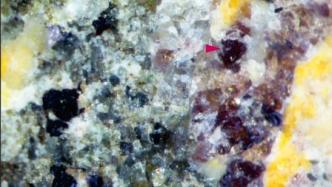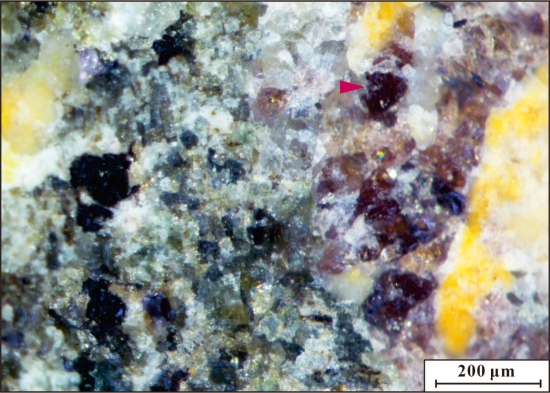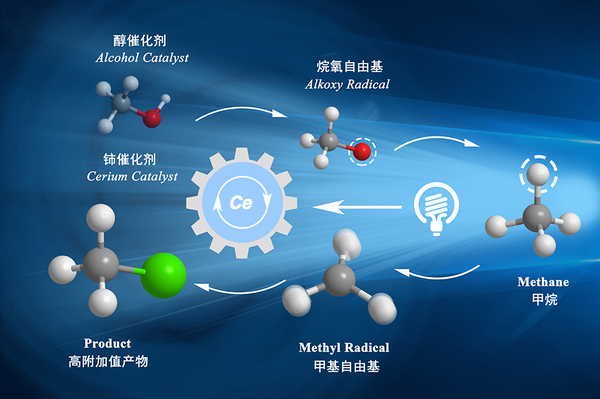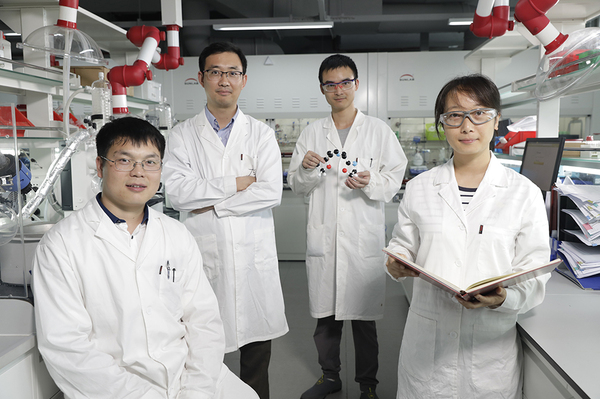

The newly discovered rare earth silicate mineral Nipeite and its associated mineral combinations. Map of Tianjin Geological Survey Center of China Geological Survey
On January 19, the China Geological Survey of the Ministry of Natural Resources announced that a new mineral discovered in a rare earth mine in Henan was officially approved by the International Mineralogical Society and was named Nipeiite-(Ce).
This new mineral, named after Chinese geologist Professor Ni Pei of the School of Earth Sciences and Engineering of Nanjing University, is the silicate mineral with the largest cerium (shì) element currently found in nature.
On the 19th, Sima Xianzhang, deputy chief engineer of the Tianjin Geological Survey Center of the China Geological Survey, who participated in the declaration of the mineral, told The Paper that alloys containing the rare earth element cerium (Ce) are resistant to high temperatures and pressure, and have very good strength and toughness. They are used in aviation It has applications in aerospace and other high-tech fields, such as engines.
Sima Xianzhang said that the reason why Nipei stone is said to be a new mineral is that its crystal structure, chemical composition, and molecular formula are all discovered for the first time and have not been found in nature in the past.
He said that mineralogy research provides basic research support for mineral processing, mineral prospecting and mining development. The discovery of new minerals not only makes important contributions to human basic science, but also in the field of applied science, people can also know which minerals specific elements are stored in when mineral processing. "When we process minerals, we first select the minerals and then extract their rare earth elements. Therefore, the discovery of minerals provides a very important scientific basis for our mineral processing."
Public reports on rare earths from Science and Technology Daily and other media show that cerium is a rare earth resource unique to China, accounting for more than 50%. It is cheap and has unique photophysical properties. Cerium alloys are resistant to high heat and can be used to make jet propeller parts . Cerium has a small neutron capture cross-sectional area and can be used as a diluent for reactor fuel.
Research results from Shanghai University of Science and Technology use cerium-based catalysts to make rocket propellant fuel more environmentally friendly.
"Mineralogy Olympiad"
According to news released by the Tianjin Geological Survey Center of the China Geological Survey (North China Geological Science and Technology Innovation Center), Ni Peishi was found in the rare earth mine of Taiping Town, Xixia County, Henan Province. The color is light red to reddish brown, gray-white and translucent under single polarized light. -Transparent glass with luster, brittleness, shell-shaped fracture, and calculated density of 4.943 grams per cubic centimeter.
According to news released by the Henan Provincial Nuclear Technology Application Center, the application for Nipei Stone Minerals was made by Qu Kai and Sima Xianzhang of the Tianjin Geological Survey Center of the China Geological Survey and Li Jinghui , a professor-level senior engineer of the Henan Provincial Nuclear Technology Application Center. The discovery of new minerals, known as the " Olympics of Mineralogy ", is one of the important symbols of a country's mineralogy research level. It is an important basic research work in the field of mineralogy and provides a basis for people's understanding and utilization of new substances in nature. Scientific basis.
Sima Xianzhang told The Paper about the discovery process of Ni Peishi.
He said that in 2013, a rare earth mine was discovered in Taiping Town, Xixia County, Henan Province, and he took his student Comrade Qu Kai to the field to investigate. Detection of mineral composition by screening. In 2019, they discovered a new mineral, peacestone.
Taipingshi is a fluorine-containing rare earth silicate mineral.
Ni Peishi is the second new natural mineral discovered in the rare earth mine of Taiping Town, Henan, after Taiping Stone by the new mineral research team of the Tianjin Geological Survey Center and the Henan Nuclear Technology Application Center team.
The mineral number of Ni Peishi is IMA No.2022-106a, the molecular formula is Ce9Fe3+(SiO4)6[SiO3(OH)](OH)3, it belongs to the trigonal crystal system, space group R3c, unit cell parameter a=10.897(2), c =38.739(8) Å.
As rare rare earth silicate minerals, Nipei stone and Taiping stone often coexist with the equally rare rare earth fluoride. They are considered to be the precursors of rare earth carbonate minerals (the main ore minerals of rare earth minerals). They are important for exploring the early formation of rare earth deposits. The properties of ore fluids and the later migration and precipitation mechanisms of rare earth elements are of important research value.
The discovery of Ni Peishi, especially its unique chemical composition and crystal structure characteristics , broke the previous classification and naming system of the cerite superfamily . Therefore, IMA-CMNNC invited the leader of the research team to participate in the revision of the classification and naming scheme for the cerite superfamily. work, the revised new plan systematically standardizes and explains in detail the mineral definitions, general crystal chemical formulas and independent crystallographic occupancies of the group, and upgrades China's "Taipingshi" to a mineral subgroup, as cerite The root of the fluorine-rich end-member mineral species in the superfamily has enriched the mineral naming scheme with Chinese cultural characteristics and increased China's influence in the field of international new mineral research.
The mineral is named after Professor Ni Pei to pay tribute to his long-term outstanding achievements in the research fields of tungsten, tin polymetallic and rare and rare earth mineral deposits.
The relevant webpage of Nanjing University shows that Ni Pei, a native of Huainan, Anhui, was born in December 1963, a professor and doctoral supervisor. The research direction is mineral deposits and geological fluids. He once served as deputy secretary of the Party Committee of the School of Earth Science and Engineering of Nanjing University. He is currently the deputy director of the State Key Laboratory of Endogenous Metal Mineralization Mechanism Research and the director of the Institute of Geological Fluids. His main academic part-time positions include Chairman of the Mineral Inclusions Working Group of the International Mineralogical Association and Secretary-General of the International Ore-forming Fluid Inclusions Committee.
From lighters to rocket propellant fuel
Song Dan, a member of the Wuhan Scientists Popularization Group , published an article in Science and Technology Daily stating that cerium is the 58th element in the periodic table. It is a very reactive metal that turns into powder when burned. It is also the most abundant rare earth metal. In 1803, the German scientist Klaproth discovered an oxide of a new element in a red heavy stone produced in the small Swedish town of Vastras, which appeared ocher when burned. At the same time, the Swedish chemist Bezilius and Hisinger also found oxides of the same element in the ore. Until 1875, people used electrolysis to obtain metallic cerium from melted cerium oxide.
According to the article, ferrocerium alloys mixed with other rare earth elements can produce beautiful sparks when rubbed against hard objects, igniting surrounding combustibles. They are key materials in ignition devices such as lighters and spark plugs. Cerium is also a good glass additive that can absorb ultraviolet and infrared rays. It is widely used in automobile glass. It not only protects against ultraviolet rays, but also reduces the temperature inside the car to save electricity for air conditioning.

Schematic diagram of photo-promoted cerium-catalyzed carbon-hydrogen bond functionalization reaction of methane.
In July 2018, the School of Physical Science and Technology of Shanghai University of Science and Technology announced that Zuo Zhiwei’s scientific research team at the school had made breakthrough progress in the important energy and chemical field of light-promoted methane conversion: they successfully developed a cheap and efficient Synergistic catalytic system of cerium-based catalyst and alcohol catalyst. This breakthrough in the field of basic research solves the scientific problem of using light energy to convert methane into liquid products in one step at room temperature, and provides a new and more economical way to convert methane into high value-added chemical products, such as rocket propellant fuel. , environmentally friendly solutions. At the same time, in-depth research and further promotion and application of this efficient and sustainable light-promoted cerium catalysis mode will provide new ideas and prospects for the efficient utilization of unique rare earth metal resources in China. In the early morning of July 27, 2018, Beijing time, this major scientific research result was published online in the top international academic journal "Science" under the title "Selective functionalization of methane, ethane, and higher alkanes by cerium photocatalysis".

Photo-promoted methane conversion research team group photo (from left): Huan Hua (co-first author), Zuo Zhiwei (corresponding author), Pan Hui (second author), Guo Jingjing (co-first author).